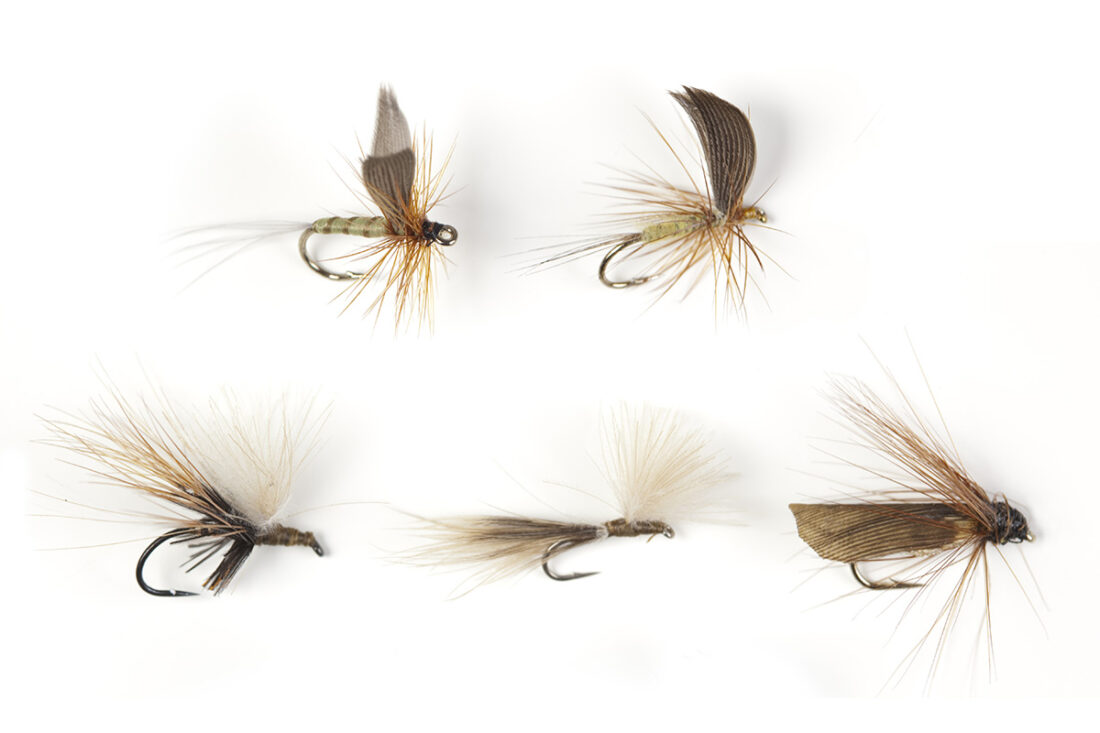From the endless variety of insects, fish, crabs, lizards, mice, and eggs that fish are likely to eat, you can guarantee that some creative fly-fisherman has made a fly to mimic it. Because of this freedom of creation, there is a seemingly endless selection of flies and fly patterns for anglers to choose from. It can be difficult for beginners to understand what flies exist and when to use specific flies. Below we’ll review the basics for selecting a fly.
- What is a fly?
- Types of Flies
- Dry Flies
- Nymphs
- Streamers
- Imitation Flies
- Fly Patterns by Fish Species
- Matching the Hatch
- Fly Sizes
What is a fly?
A fly is a bunch of material tied to a hook, or multiple hooks, using thread to like a particuler insect or organism fish feed on. The materials used today to construct a fly are endless and can range from natural feathers and fur to synthetic fibers from your local hobby shop. These materials are often combined into a single fly to create stunning mimicries of nature.
If there is a particular insect or organism a fish feeds on, you be assured that a fly exists to mimic it. Most people only associate fly-fishing with trout; however, fly fishing is used to target a large variety of fish from Blue-Marlin to Common Carp and every fish in between. Fly fishing flies will vary by target fish species, time of year, weather conditions, and environment. This makes fly-fishing, and fly tying, an endless pursuit and constantly changing puzzle.
The most important thing to remember is that each fish species has its preferred insect, so it’s important to use flies that will attract the fish species that are present in your waters. If your only local gamefish are panfish, it’s useless to fish with flys designed for trout.
Types of Flies
There are four main types of flies: dry flies, nymphs, streamers, and imitations. Although all flies can be considered imitation flies to one extent or another, categorically, imitation flies mimic a specific prey or bait. Flies are differentiated according to body style, uses, and subjective determination by the angler.
Below we’ll begin by exploring the type of flies designed to target trout and panfish and work our way to streamers and imitation flies. Trout and panfish-specific fly categories include dry flies and nymphs. Although these flies can be used to target species other than trout and panfish, they are typically too small for larger predatory fish to even notice.
Dry Flies
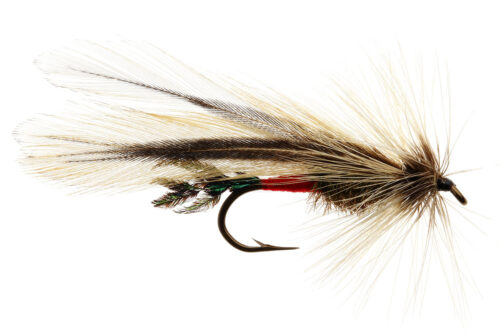
Dry flies mimic small flying insects landing or hatching on the water’s surface. To stay afloat, dry flies are incredibly lightweight and rely on the surface tension of the water and the surface area of the fly to remain on the surface.
Many types of dry flies exist, and most attempt to mimic a specific type of insect or invertebrate. These insects may include Stoneflies, Midges, Mayflies, Caddis flies, grasshoppers, crickets, and ants, among others. Most dry flies that mimic insects have specific names that can be confusing and subjective but are assigned by their original creators who made them famous. The most common types of dry flies for fishing trout and panfish include Elk Hair Caddis, Parachute Adams, Griffith’s Gnat, Stimulator, Pale Morning Dun, and Blue Wing Olive.
- Elk Hair Caddis – As the name suggests, this type of fly attempts to mimic a caddis fly and, you guessed it, originally was constructed using Elk’s hair; however, deer and other large mammals can be used as a substitute. This fly is best used during the elk hair caddis hatch.
- Parachute Adams – is an extremely popular dry fly that has been around for generations. It does not mimic any “specific” insect but is still effective at catching trout. The defining feature of this fly is its “parachute” that guides the fly in the air and forces it to land upright every time it’s on the water’s surface.
- Griffith’s Gnat – Was popularized decades ago by George Griffith and attempts to mimic the biggest gnat you have ever seen on the surface of the water. Like any other fly on this list, the colors of Griffith’s Gnat can be changed to mimic distinct insect species or nymph stages floating on the water’s surface.
- Stimulator – The Stimulator is the one size fits all dry fly. Usually full of wacky colors and patterns, this fly attempts to mimic multiple different insects at once and can be especially useful when first assessing a location for what the trout are eating.
- Pale Morning Dun and Blue Wing Olive – These two flies are similar in their design and construction except that the Pale Morning Dun mimics a Mayfly while the Blue Wing Olive mimics a Blue Wing Olive fly. Both flies can be fished year round but are most effective when fished during their respective hatches.
Nymphs
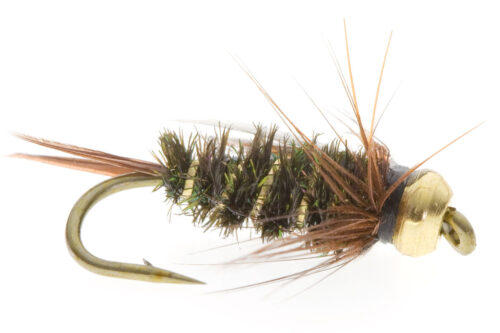
Nymphs replicate the larve of insects, such as caddisflies, stoneflies, mayflies, and others. The nymph is typically the earliest stage of an invertebrate’s lifecycle. These flies can sometimes be very small, with anglers using a magnifying glass to thread the hook. A wet fly is the adult stage of the nymph’s life cycle, typically trying to ascend to the water’s surface or floating in the current, searching for some vegetation to cling to. Think about all the little squirmy creatures you see when looking into a stagnant pool of water. Those are the nymph stages.
Many anglers consider the nymph the most effective fly for catching trout on any river. Nymphs are typically very small, ranging from size 14-26 size hooks, with reports of some people in the past even tying size 26 nymphs. Many variations and types of nymphs can be used in as many colors as you can dream up. However, some patterns are a step above the rest. These patterns include the Zebra Midge, Double bead midge, Scuds, jujubaetis, soft-hackle flies, and Hare’s Ear Nymphs.
The nymph flies listed below can catch trout and panfish year round; however, using specific patterns, colors and sizes of nymphs to match the hatch of insect species in the area typically produces the best catch rate.
- The Zebra Midge – One of the most used nymphs, this simple fly has a single bead below the eyelet and layers of distinct color threads down the hook’s shaft with a Zebra pattern. Midges are great to use year around and will typically always catch fish.
- Double Beaded Midge – also a midge; this fly is fantastic when fishing deep holes, cuts or getting near the bottom is a priority. The second bead assists in sinking this lure as quickly as possible. Always an excellent choice when scouting a new area. Many variations of this midge exist and can be deployed in various fishing ecosystems.
- The Scud – the bigger, uglier brother to the midge, a beaded scud fly has a round body and hackles on the front and the back designed to mimic sow bug species. These flies are a great year-round options to fish, especially in rivers where sow bugs thrive. Stick with dark and dull colors.
- Jujubaetis – is a slightly more complex version of a midge with additional frills on the front end designed to mimic a blue-wing olive nymph. Many variations of this fly exist that mimic other various hatching species such as the mayfly and stonefly. Jujubaetis flies are best in the spring and winter at the front end of the blue-wing olive hatch.
- Hare’s Ear Nymph – Similar to other nymphs on this list, this fly can mimic a large variety of hatches. It’s an ideal fly to use on slow days or days when you don’t know what is hatching. By changing the colors of this fly you can imitate anything from a stonefly nymph to mayfly and everything in between.
- Soft Hackle Flies – Soft hackle flies are the true “wet flies” on this list and represent the intermediary stage between nymphs and adult insects. The soft hackle fly is particularly effective during caddis fly, blue-wing olive, and mayfly hatches.
Streamers
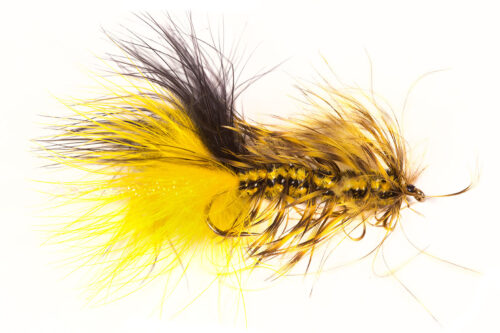
Streamers are designed for active predatory fish that feed in the middle or top of the water column. The main intention of a streamer is to mimic a baitfish instead of an insect. Streamers range in size from small micro-streamers used for mountain brook trout to monstrous 15+ inch long streamers designed to mimic a small tuna for catching blue marlin. Streamers are commonly used to fish largemouth bass, smallmouth bass, brown trout, rainbow trout, redfish, bonefish, tarpon, salmon, and the like. Some classic streamer patterns that can range dramatically in size include the Wooly Bugger, Clouser minnow, Muddler Minnow, Sculpin, and Zonker.
Streamers are highly versatile and can be fished year-round without worrying about insect hatches. However, you’ll have best results if you use streamers that mimic the native baitfish in the area you’re fishing. The following are some of the most popular, and versatile, streamers used when fly fishing.
- Wooly Bugger – quite possibly the most famous streamer, the Wooly Bugger can be used for fishing all trout species. It can also be used to target a variety of other game fish species. Use the Wooly Bugger year around in many sizes and colors, and you’re sure to get a bite.
- Clouser Minnow – A great fly to throw for species that eat small minnows and baitfish in fresh and saltwater. If your target fish will eat a minnow, it will likely take a Clouser. Clouser minnows can be used year around and come in an endless number of colors.
- Muddler Minnow – This streamer mimics small bottom-dwelling fish and crayfish darting along the bottom. This fly can be used in fresh or saltwater to target areas where mud minnows and crawfish are common.
- Sculpin – If you have never seen a sculpin, look it up. These small bottom-dwelling fish are a favorite feeder for large trout and smallmouth bass. Sculpin flies were all the rage a few years ago when some truly monstrous trout were caught on them around the country. They’re still effective today.
- Zonker – The Zonker pattern is typically a beefier version of the clouser minnow and is designed to mimic a larger baitfish. These streamers have a more extensive profile in the water and are great for fast-moving and cloudy water. Zonkers can be small or large, depending on the species you are trying to mimic and the target catch.
- Leech – Typically constructed of a single piece of rabbit fur, the leech is a highly effective streamer when used for targeting predatory game fish. There are many variations of the leech fly. One of the more popular is the egg-sucking leech fly.
Imitation Flies
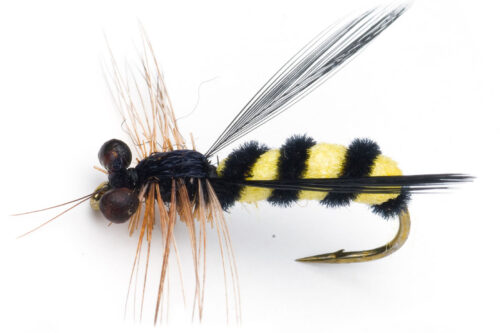
There are a large variety of flies that do not fit into one of the previously mentioned categories. We generally refer to such flies as imitation flies. Don’t let the fact that these flies do not fall into any category fool you. Imitation flies can be the deadliest in your tackle box.
Imitation flies are designed to mimic specific organisms and are used for targeting specific game fish species. For example, imitation flies designed to mimic small crabs and shrimp are ideal for targeting bonefish on the flats, where their natural prey consists of small crabs and crustaceans. Likewise, the imitation egg pattern fly is used to target hungry trout that are accustomed to feeding on the eggs of spawning salmon that are kicked up in the current.
The following are some of the more popular imitation flies.
- Egg Pattern – Egg patterns are designed to look like salmon eggs. They are very effective, especially during salmon spawns.
- Mop Fly – This fly looks a lot like a mop. It utilizes colored mop fibers as a body for the fly. No one really knows what this fly is supposed to look like, some suggest a nymph eating a salmon egg, but for some reason, trout cannot get enough of it.
- Egg-Sucking Leech – The most famous streamer for steelhead, the egg-sucking leech, is a deadly streamer that looks like a giant leech eating a salmon egg. Highly specific but extremely effective.
- The Squirmy Worm – Sometimes known as the san juan worm. It is designed to mimic a red worm accidentally swept away into the current. It is created using a single long piece of red, green, or orange stringy material, often Chenille. This fly produces a life-like movement that trout find irresistable.
- Hopper Patterns – These patterns are designed to float on the surface and “twitch” like a grasshopper falling into the river. Hopper patterns are effective mid-summer when grasshoppers and day insects are most abundant.
- Poppers, Plugs and Frog Patterns – These flies are a mix between dry-flies and streamers. A large foam, or wooden head causes the fly to float on the surface of the water, resembling a frog, insect or dying baitfish.
- Crustacean Patterns – These patterns are designed primarily for saltwater fish including redfish, bonefish, permit, and tarpon. Crustacean patterns are fished on or near the bottom of grass flats. They are designed to mimic a small crab or shrimp foraging in the grass.
- Mice, Snake, and Small Animal Patterns – If you thought flies were limited to fish and insects, guess again. These patterns are self-explanatory; typically, if you throw one, you are trying to target giant fish.
Fly Patterns by Fish Species
Some flies are made with specific fish in mind. Here is a quick breakdown of some of some common fly-fishing species and what flies are used to catch them. (See Table 1 below.)
- Trout and Salmon – Depending on environmental conditions, almost all flies mentioned on this list can be used for trout and salmon. However, it’s essential to always try and match the hatch.
- Bonefish and Permit Patterns – These flies are designed to look like small crustaceans and shrimp found on the flats where these fish species feed. Bonefish, especially permits, can be highly selective, so matching fly patterns to the native fauna is crucial to fishing success.
- Redfish Patterns – Redfish are always hunting for mud minnows and crustaceans that as the leave their burrows. Flies designed to resemble mud minnows, fiddler crab, blue crab and other native crustaceans are effective for catching redfish.
- Largemouth and Smallmouth Bass Patterns – Fly Patterns for Largemouth and Smallmouth bass are similar in design to traditional bass tackle and patterns. Long 6+ inch worm patterns constructed of a single piece of fiber and streamer patterns are commonly used for bass.
- Carp Patterns – Believe it or not, landlocked freshwater fishermen fly fish for carp regularly and absolutely cannot get enough of it. Carp fly patterns can resemble vegetation, fruit, and small invertebrates. The carp’s favorites are large nymph patterns, squirmy worms, and wooly buggers.
- Pike and Muskie Patterns – You might as well go big or go home when fishing for muskie and pike. Considering some muskie lures are over 15 inches long, you can expect the size of the flies to match.
| Dry Flies | Nymphs | Streamers | Egg Patterns | Crustaceans | Poppers | Animal Patterns | |
|---|---|---|---|---|---|---|---|
| Trout and Salmon | X | X | X | X | X | X | |
| Bonefish and Permit | X | X | |||||
| Red Fish | X | X | X | ||||
| Bass | X | X | X | X | |||
| Carp | X | X | X | ||||
| Pike & Muskie | X | X | X |
Matching the Hatch
Matching the hatch has been a conversation topic for years among conventional and fly anglers alike. The general idea is that predatory fish “lock on” to a specific feed source in an area when an abnormally higher abundance of that feed source is present. For instance, when a mayfly hatch occurs on a river, the trout on that river will look for mayflies and ignore most other bugs and organisms. This makes choosing the correct fly easy for the angler unless he does not have a mayfly imitation.
Before going fly-fishing for trout or any species, it is best to discover what insect hatch or baitfish migration occurs in that area. Charts exist regionally or even by individual river for most fishing spots in the United States.
Fly Sizes
The number given to a fly size depends on the size of the hook it is tied to. The larger the number is, the smaller the fly, and for sizes smaller than #2, it is always an even number. So a #18 Adams will be smaller than a #12 Adams, with a difference of four hook sizes between them.
Very large hooks are referred to as “ought” sizes, so a hook or fly that is 1/0 will be known as a “one-ought” or “one-oh.” Review our hook size chart to get an idea of the correct fly sizes for target game fish species.


